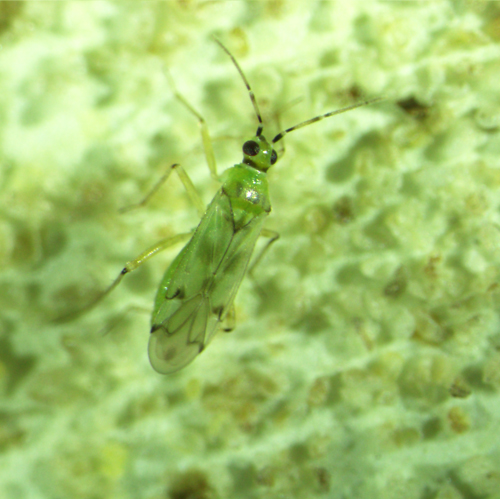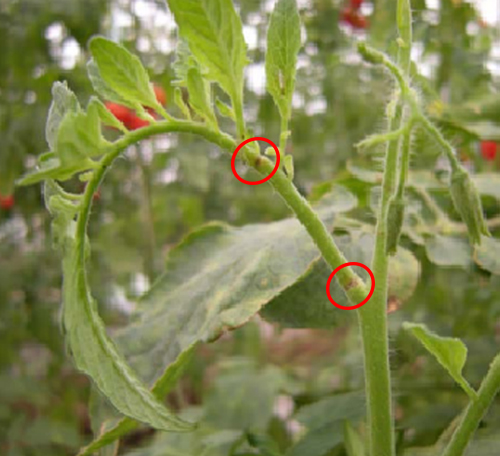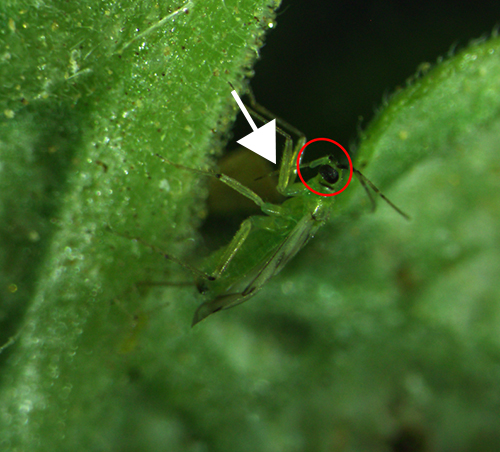common name: tomato bug, tobacco leaf bug, tomato mirid, green tobacco capsid
scientific name: Nesidiocoris tenuis Reuter (Insecta: Hemiptera: Miridae)
Introduction - Synonymy - Distribution - Description and Life Cycle - Biology and Host Plants - Prey Insects - Economic Importance - Selected References
Introduction (Back to Top)
Nesidiocoris tenuis Reuter (Figure 1), is a small hemipteran about 5-6 mm in size present in tomato and many other vegetable crops and is considered to be a beneficial insect because of its predatory nature on many insect pests including aphids and thrips (Sanchez and Lacasa 2008, Gavkare and Sharma 2016, Kim et al. 2016). However, it also feeds on plants in the absence of its prey. In tomato, the feeding results in brown and eventually necrotic rings, which are sometimes evident on stems, flowers, and fruits (Figures 2 and 3) (Arno et al. 2006, Calvo et al. 2009, Kim et al. 2016).
Figure 1. Adult tomato bug, Nesidiocoris tenuis Reuter. Photograph by Johanna Bajonero, Entomology and Nematology Department, Southwest Research and Education Center, University of Florida.
Figure 2: Brown ring formed by feeding of Nesidiocoris tenuis on a tomato plant. Photograph by Jacobson Rob, Agriculture and Horticulture Development Board. http://www.robjacobsonconsultancy.co.uk/
Figure 3: Tomato plant damage caused by feeding on stems and petioles. Photograph by Jacobson Rob, Agriculture and Horticulture Development Board. http://www.robjacobsonconsultancy.co.uk/
Synonymy(Back to Top)
Nesidiocoris tenuis was formerly called Cyrtopeltis crassicornis Distant, Cyrtopeltis ebaeus Odhiambo (1961), Cyrtopeltis javanus Poppius (1914), Cyrtopeltis tenuis Reuter (1895), Dicyphus nocivus Fulmek (1925), Dicyphus persimilis Poppius (1910), Dicyphus tamaricis Puton (1886), Engytatus tenuis, Engytatus volucer (Kirkaldy), Gallobelicus crassicornis Distant (1904), Nesidiocoris tenuis Kerzhner (1988) and Nesidiocoris volucer Kirkaldy (1902) (ITIS 2020, EPPO 2020, CABI 2020).
Distribution (Back to Top)
Nesidiocoris tenuis is particularly prevalent on tomato under protected structures (greenhouse, shade house) and field conditions (Arnó et al. 2006; Sanchez and Lacasa 2008). It is widely distributed in Mediterranean countries (Spain’s and the Canary Islands), Europe, Asia, North Africa, Central America, South America, the Caribbean, and North America (Sanchez et al. 2009, Bhatt and Patel 2018). Specifically, it has been found to feed on the South American tomato leafminer Tuta absoluta Meyrick (Lepidoptera: Gelechiidae), an important pest of tomato in Algeria, Egypt, Cyprus, Egypt, France, Jordan, Iran, Israel, Italy, Morocco, Spain, Senegal and Turkey (El Arnaouty and Kortam 2012, Zappala et al. 2013, Sylla et al. 2016). Nesidiocoris tenuis was first discovered in Egypt preying on the tomato leaf miner, Tuta absoluta in an eggplant and tomato plantation in 2011 (El Arnaouty and Kortam 2012). In 2016, it was recorded in Senegal in tomato fields preying on the tomato leaf miner, Tuta absoluta (Sylla et al. 2016). Although, Tuta absoluta is currently not present in the USA, but it is a pest of concern (Tabuloc et al. 2019). Florida Cooperative Agricultural Pest Survey (CAPS) Program is actively monitoring the presence and arrival of this pest in Florida (Hodges, 2013).
Description and Life Cycle (Back to Top)
Nesidiocoris tenuis can be used as a biological control agent for some agricultural pests including thrips, aphids, and mites. Nesidiocoris tenuis is characterized by the presence of a stylet (Figure 4), which is used for extracting liquid substances either from prey or plants and the ovipositor for depositing and inserting eggs in the plants (Wheeler 2001, Triplehorn and Johnson 2005, Whitfield and Purcell 2014). One generation of Nesidiocoris tenuis can take 14.9 days (35°C), 21.8 days (25°C), or 86.7 days (15°C) to develop depending on environmental factors like temperature and what they fed on (Sanchez et al. 2009).
Figure 4: Head (red circle) and Stylet (white arrow) of Nesidiocoris tenuis. Photograph by Johanna Bajonero, Entomology and Nematology Department, Southwest Research and Education Center, University of Florida.
Egg: The female of Nesidiocoris tenuis lays a single egg on younger leaves and flowers (Bhatt and Patel 2018). The egg is oval, pellucid, and white when it is laid, and a few days after it darkens to red and eventually to brown before hatching (Patel 1974).
Nymphs: Nesidiocoris tenuis has five nymphal or immature stages before reaching adulthood. During the first stage, the insect is yellowish-white when they are newly hatched. At this stage, wings are absent, there is no differentiation between the three body regions (head, thorax, and abdomen) and no hardening of the exoskeleton, which is the external covering for the body. Hardening of the exoskeleton begins at the second nymphal stage, in which there is a clear difference between the three body regions. There are dark brown compound eyes at all nymphal stages. In the third and fourth nymphal stages, the wing buds are seen (Figure 5). At the fifth nymphal stage, many parts of the body of the insect resemble that of an adult (Kim et al. 2016, Sylla et al. 2016, Patel 1974). Nymphs are greenish but they lack the black spots and black bands present in adults (Vacante and Tropea 1994). All nymphal stages lack the scutellum, a triangle like shield found at the back of the adult (Figure 6) (Kim et al. 2016).
Figure 5: Nymphs: a) early nymphal stage of Nesidiocoris tenuis without wing buds; b) late nymphal stage of Nesidiocoris tenuis with wing buds (red circle). Photograph a) by Johanna Bajonero, Entomology and Nematology Department, Southwest Research and Education Center, University of Florida, b) by Jacobson Rob, Agriculture and Horticulture Development Board. http://www.robjacobsonconsultancy.co.uk/
Adult: The adult of Nesidiocoris tenuis is green in color and varies from 6 -10 mm in length (Sylla et al. 2016). The body is elongated and slender, antennae are pale brown. The female is larger than male and has a more rounded oval shape body (El-Dessouki et al. 1976, Kim et al. 2016). What differentiates this species from other mirids is the black band at the back of the eyes. In the genus Macrolophus, the black band is absent (Figure 6).
Figure 6: Presence and absence of black band behind the eyes. Left (Macrolophus brevicornis Knight). Photograph by Mike Quinn, www.bugguide.net. Right (Nesidiocoris tenuis Reuter) marked with a white arrow. Triangle-like shield (scutellum), marked with the red circle. Photograph by Johanna Bajonero, Entomology and Nematology Department, Southwest Research and Education Center, University of Florida.
Biology and Host Plants (Back to Top)
Nesidiocoris tenuis has been reared under laboratory conditions on tomato plants and Ephestia Kuehniella (Sanchez 2008), and it has been used as a biocontrol agent under field and laboratory conditions. Adults and nymphs feed on plants and cause injury in the absence of prey. Feeding by Nesidiocoris tenuis affects plant growth and reduces the quality and quantity of yield (Castañe et al. 2011). Host plants of Nesidiocoris tenuis include but are not limited to tomato, sweet pepper, cucumber, zucchini, yellow squash, sesame, tobacco, aubergine, and potato. (El-Dessouki et al. 1976, Biondi et al. 2016, Kim et al. 2016)
Prey insects (Back to Top)
As a biological control agent, Nesidiocoris tenuis feeds on the eggs and larvae of Helicoverpa armigera Hübner (Lepidoptera: Noctuidae) (tomato fruit borer), Keiferia lycopersicella Walsingham (Lepidoptera: Gelechiidae) (tomato pinworm), Manduca sexta L. (Lepidoptera:Sphingidae) (tomato or tobacco hornworms), (leaf-eating caterpillars), Symmetrischema tangolias Gyen (Lepidoptera: Gelechiidae) (tomato stem borer), Tuta absoluta (tomato leaf miner) (Desneux et al. 2010, Urbaneja et al. 2009), Bemisia tabaci Gennadius (Hemiptera: Aleyrodidae) (Whitefly) (Alomar et al. 2006, Calvo et al. 2012, Bhatt and Patel 2018, Gavkare and Sharma 2014), thrips, aphids, and mites (Gavkare and Sharma 2016).
Economic Importance (Back to Top)
Nesidiocoris tenuis has been shown to be a beneficial insect for managing populations of agricultural pests. In some countries like Egypt and France, Nesidiocoris tenuis is considered a pest of tomato, while in Sicily, Spain, and many other countries, it is considered to be a beneficial insect for biological control (Castañe et al. 2011). Nesidiocoris tenuis has been used for successful control of whitefly in a multi-tunnel greenhouse (Calvo et al. 2012). Various experiments have been conducted in greenhouses to evaluate the effectiveness of Nesidiocoris tenuis on greenhouse pests. These pests include whitefly (Bemisia tabaci Biotype B on tomatoes, and thrips Frankliniella occidentalis Pergande (Thysanoptera: Thripidae) on sweet pepper (Calvo et al. 2012, Bouagga et al. 2018). Sanchez (2008) observed that Nesidiocoris tenuis population increases when whitefly population is high and vice versa. However, it is important to have the correct ratio of predator to prey to achieve successful control of the pests and reduce damage to plants when prey population is low or absent (Sanchez 2008, Desneux et al. 2010, Calvo et al. 2012, Kim et al. 2016).
Selected References (Back to Top)
- Hodges, A. 2013. Tomato leafminer, a pest of concern for Florida. Entomology and Nematology Newsletter. Florida Department of Agriculture and Consumer Services: Cooperative Agricultural Pest Survey (CAPS).
- Arnó J, Castañé C, Riudavets J, Roig J, Gabarra R. 2006. Characterization of damage to tomato plants produced by the zoophytophagous predator Nesidiocoris tenuis. IOBC/WPRS Bulletin 29:249-254.
- Bhatt NA, Patel MV. 2018. Tomato bug, Nesidiocoris tenuis (Reuter): A zoophytophagous insect. Journal of Entomology and Zoology Studies. 6:1550-1556.
- Biondi A, Zappala L, Di Mauro A, Garzia GT, Russo A, Desneux N, Siscaro G. 2016. Can alternative host plant and prey affect phytophagy and biological control by the zoophytophagous mirid Nesidiocoris tenuis? BioControl. 61:79-90.
- Bouagga S, Urbaneja A, Pérez-Hedo M. 2018. Comparative biocontrol potential of three predatory mirids when preying on sweet pepper key pests. Biological Control. 121: 168-174.
- CABI. 2020. Invasive species compendium: Nesidiocoris tenuis (tomato bug). Viewed 22 May 2020.
- Calvo FJ, Bolckmans K, Belda JE. 2012. Release rate for a pre-plant application of Nesidiocoris tenuis for Bemisia tabaci control in tomato. Biocontrol 57: 809-817.
- Castañé C, Arnó J, Gabarra R, Alomar O. 2011. Plant damage to vegetable crops by zoophytophagous mirid predators. Biological control. 59: 22-29.
- Desneux N, Wajnberg E, Wyckhuys KAG, Burgio G, Arpala S, Narváez-Vásquez CA, González-Cabrera J, Ruescas DC, Tabone E, Frandon J, Pizzol J, Poncet C, Cabello T, Urbaneja A. 2010. Biological invasion of European tomato crops by Tuta absoluta: ecology, geographic expansion, and prospects for biological control. Journal of Pest Science. 83:197-215.
- El Arnaouty SA, Kortam MN. 2012. First record of the mirid predatory species, Nesidiocoris tenuis Reuter (Heteroptera: Miridae) on the tomato leafminer, Tuta absoluta (Meyrick) (Lepidoptera: Gelechiidae) in Egypt. Egyptian Journal of Pest Control. 22: 223-224.
- El-Dessouki SA, El-Kifl AH, Helal HA. 1976. Life cycle, host plants and symptoms of damage of the tomato bug, Nesidiocoris tenuis Reut. (Hemiptera: Miridae), in Egypt. Journal of Plant Diseases and Protection. 83:204-220.
- European and Mediterranean Plant Protection Organization (EPPO). 2020. Nesidiocoris tenuis (CRYOTE). EPPO Global Database. Viewed on 22 May 2020.
- Gavkare O, Sharma PL. 2014. New record of Nesidiocoris tenuis (Reuter) (Hemiptera: Miridae) associated with Bemisia tabaci Gennadius (Hemiptera: Aleyrodidae) on tomato from Maharashtra, India. Journal of Biological Control. 28:117-118.
- Gavkare O, Sharma PL. 2016. Feeding potential of Nesidiocoris tenuis (Reuter) on the two spotted spider mite, Tetranychus urticae Koch, under laboratory conditions. Journal of Agricultural and Urban Entomology. 32:50-58.
- Integrated Taxonomic Information System (ITIS). 2020. Nesidiocoris tenuis (Reuter, 1895). (Online) (Viewed 22 May 2020) Available from the World Wide Web: https://www.itis.gov/
- Jacobson R. 2018. Nesidiocoris tenuis biology and Identification. Agriculture and Horticulture Development Board.
- Kim JG, Lee WH, Yu YM, Yasunaga-Aoki C, Jung SH. 2016. Life cycle, biology, and descriptions of greenhouse biological control agent, Nesidiocoris tenuis (Reuter, 1895) (Hemiptera: Miridae). Journal of the Faculty of Agriculture. 61:313-318.
- Patel NG. 1974. The bionomics and control measures of tobacco bug Nesidiocoris tenuis Reuter (Miridae: Hemiptera). Dissertation, Doctor of Philosophy in Agricultural Entomology. GUJARAT. India.
- Sanchez J.A. 2008. Zoophytophagy in the plantbug Nesidiocoris tenuis. Agricultural and Forest Entomology. 10:75-80.
- Sanchez JA, A. Lacasa. 2008. Impact of the Zoophytophagous plant bug Nesidiocoris tenuis (Heteroptera: Miridae) on tomato yield. Journal of Economic Entomology. 101:1864-1870.
- Sánchez J, Lacasa A, Arnó J, Castañe C, Alomar O. 2009. Life history parameters for Nesidiocoris tenuis (Reuter) (Heteroptera: Miridae) under different temperature regimes. Journal of Applied Entomology. 133:125-132.
- Sylla S, Brévault T, Streito JC, Diarra K. 2016. First record of Nesidiocoris tenuis (Reuter) (Heteroptera: Miridae), as a predator of the tomato leaf miner, Tuta absoluta (Meyrick) (Lepidoptera: Gelechiidae), in Senegal. Egyptian Journal of Biological Pest Control. 26:851-853.
- Tabuloc, CA., Lewald KM, Conner WR, Lee Y, Lee EK, Cain AB, Godfrey KE, Arno J, Agusti N, Perini CR, Guedes JC, Zalom FG, Chiu JC. 2019. Sequencing of Tuta absoluta genome to develop SNP genotyping assays for species identification. Journal of Pest Science. 92:1397-1407.
- Triplehorn CA, Johnson NF. 2005. Borror and Delong's introduction to the study of insects. 7° edition. Brooks Cole, USA. ISBN: 978-0-03-096835-8.
- Urbaneja A, Montón H, Mollá O. 2009. Suitability of the tomato borer Tuta absoluta as prey for Macrolophus caliginosus and Nesidiocoris tenuis. Journal of Applied Entomology. 133: 292-296.
- Vacante V, Tropea G. 1994. Nesidiocoris tenuis Reuter (Hemiptera: Miridae). Natural antagonist of Aleyrodidae (tomato, Sicily). Informatore Fitopatologico. 44:23-28.
- Wheeler AG. 2001. Biology of the plant bugs (Hemiptera: Miridae): pests, predators, opportunists. Cornell University Press. pg. 507. ISBN: 9780801438271.
- Whitfield JB, Purcell AH. 2014. Daly and Doyen’s introduction to insect biology and diversity. 3° edition. Oxford University Press. ISBN: 978-0-19-538067-5.
- Zappala L, Biondi A, Alma A, Al-Jboory IJ, Arnó J, Chailleux A, El-Arnaouty A, Gerling D, Guenaoui Y, Shaltiel-Harpaz, Siscaro G, Stavrinides M, Tavella L, Aznar RV, Urbaneja A, Desneux N. 2013. Natural enemies of the South American moth, Tuta absoluta, in Europe, North Africa and Middle East, and their potential use in pest control strategies. Journal of Pest Science. 86: 635-647.





